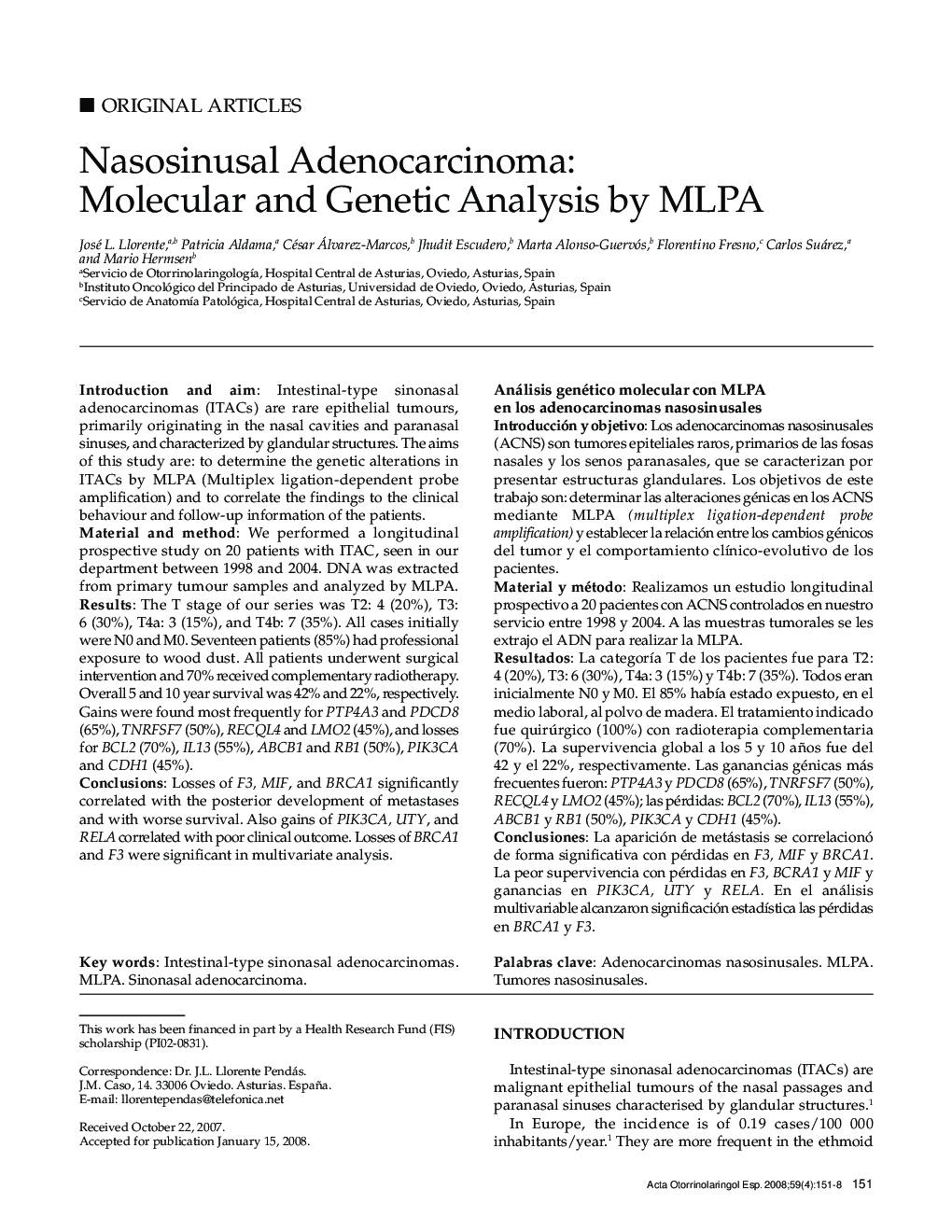| Article ID | Journal | Published Year | Pages | File Type |
|---|---|---|---|---|
| 4101549 | Acta Otorrinolaringologica (English Edition) | 2008 | 8 Pages |
Introduction and aimIntestinal-type sinonasal adenocarcinomas (ITACs) are rare epithelial tumours, primarily originating in the nasal cavities and paranasal sinuses, and characterized by glandular structures. The aims of this study are: to determine the genetic alterations in ITACs by MLPA (Multiplex ligation-dependent probe amplification) and to correlate the findings to the clinical behaviour and follow-up information of the patients.Material and methodWe performed a longitudinal prospective study on 20 patients with ITAC, seen in our department between 1998 and 2004. DNA was extracted from primary tumour samples and analyzed by MLPA.ResultsThe T stage of our series was T2: 4 (20%), T3: 6 (30%), T4a: 3 (15%), and T4b: 7 (35%). All cases initially were N0 and M0. Seventeen patients (85%) had professional exposure to wood dust. All patients underwent surgical intervention and 70% received complementary radiotherapy. Overall 5 and 10 year survival was 42% and 22%, respectively. Gains were found most frequently for PTP4A3 and PDCD8 (65%), TNRFSF7 (50%), RECQL4 and LMO2 (45%), and losses for BCL2 (70%), IL13 (55%), ABCB1 and RB1 (50%), PIK3CA and CDH1 (45%).ConclusionsLosses of F3, MIF, and BRCA1 significantly correlated with the posterior development of metastases and with worse survival. Also gains of PIK3CA, UTY, and RELAcorrelated with poor clinical outcome. Losses of BRCA1 and F3 were significant in multivariate analysis.
ResumenIntroducción y objetivoLos adenocarcinomas nasosinusales (ACNS) son tumores epiteliales raros, primarios de las fosas nasales y los senos paranasales, que se caracterizan por presentar estructuras glandulares. Los objetivos de este trabajo son: determinar las alteraciones génicas en los ACNS mediante MLPA (multiplex ligation-dependent probe amplification) y establecer la relación entre los cambios génicos del tumor y el comportamiento clínico-evolutivo de los pacientes.Material y métodoRealizamos un estudio longitudinal prospectivo a 20 pacientes con ACNS controlados en nuestro servicio entre 1998 y 2004. A las muestras tumorales se les extrajo el ADN para realizar la MLPA.ResultadosLa categoría T de los pacientes fue para T2: 4 (20%), T3: 6 (30%), T4a: 3 (15%) y T4b: 7 (35%). Todos eran inicialmente N0 y M0. El 85% había estado expuesto, en el medio laboral, al polvo de madera. El tratamiento indicado fue quirúrgico (100%) con radioterapia complementaria (70%). La supervivencia global a los 5 y 10 años fue del 42 y el 22%, respectivamente. Las ganancias génicas más frecuentes fueron: PTP4A3 y PDCD8 (65%), TNRFSF7 (50%), RECQL4 y LMO2 (45%); las pérdidas: BCL2 (70%), IL13 (55%), ABCB1 y RB1 (50%), PIK3CA y CDH1 (45%).ConclusionesLa aparición de metástasis se correlacionó de forma significativa con pérdidas en F3, MIF y BRCA1. La peor supervivencia con pérdidas en F3, BCRA1 y MIF y ganancias en PIK3CA, UTY y RELA. En el análisis multivariable alcanzaron significación estadística las pérdidas en BRCA1 y F3.
